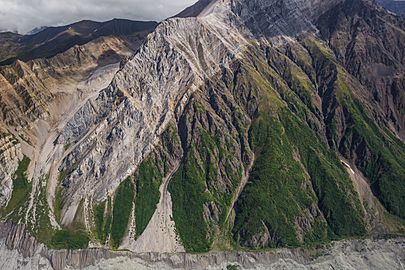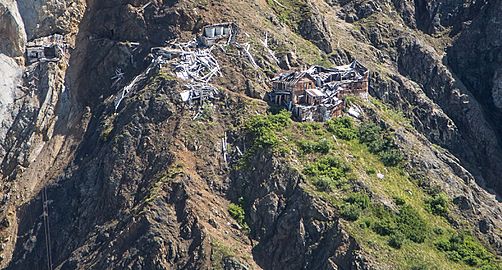Bonanza Peak (Alaska) facts for kids
Quick facts for kids Bonanza Peak |
|
|---|---|

South aspect of Bonanza Peak
|
|
| Highest point | |
| Elevation | 6,983 ft (2,128 m) |
| Prominence | 1,583 ft (482 m) |
| Isolation | 4.94 mi (7.95 km) |
| Parent peak | Peak 12454 |
| Geography | |
| Location | Wrangell-St. Elias National Park Valdez-Cordova Borough Alaska, United States |
| Parent range | Wrangell Mountains |
| Topo map | USGS McCarthy C-5 |
| Type of rock | Limestone, Greenstone |
Bonanza Peak is a tall mountain in Alaska, standing 6,983 feet (2,128 meters) high. It's part of the Wrangell Mountains. This peak was once famous for its rich copper deposits. People mined copper here from 1909 to 1938.
The mountain is located inside Wrangell–St. Elias National Park and Preserve. It's right next to Kennecott, a historic mining town. You can find it about 7 miles (11 km) northeast of McCarthy. Below the mountain's west side, two large ice rivers, the Kennicott and Root Glaciers, meet. Water from the mountain flows into the Nizina River, which then joins the big Copper River. If the weather is clear, you can see other peaks like Sourdough Peak and Mount Blackburn from the top of Bonanza Peak.
Contents
Mining History at Bonanza Peak
Bonanza Peak was home to five important mines: Bonanza, Jumbo, Mother Lode, Erie, and Glacier.
The Discovery of Copper
In August 1900, two prospectors, "Tarantula" Jack Smith and Clarence L. Warner, found the Bonanza ore body. This was a huge discovery! Early on, it was confirmed to be the richest known copper deposit in the world.
The Mines and Their Operations
- The Bonanza Mine was on a ridge south of the peak.
- The Glacier Mine was an open-pit mine, meaning it was dug from the surface. It was mostly mined during the summer.
- The Jumbo Mine was in a bowl-shaped valley (called a cirque) on the west side of the peak.
- The Mother Lode Mine was in a cirque on the east side.
- The Erie Mine was high up on the northwest slope, above the Root Glacier.
Many of these mines were connected by tunnels deep inside the mountain.
What the Mines Produced
From 1909 to 1938, these mines produced a massive amount of copper. They dug out over 4.6 million tons of rock. This rock contained more than a billion pounds of copper! They also found several million ounces of silver. The mining operations made a lot of money, with over $200 million in sales and more than $100 million in profit.
Hiking to the Old Mines
Today, you can hike to the abandoned Bonanza, Jumbo, and Erie mines. These are challenging hikes that take a full day. The trail to the Erie Mine is especially exciting, as it goes along cliffs overlooking a big icefall.
Mountain Geology
Bonanza Peak is part of a large geological area called the Wrangellia Terrane. The valuable copper deposits are found in a special spot between two different rock layers. One layer is a type of limestone called Chitistone, and the other is a green rock called Nikolai greenstone.
The copper is found in cracks and breaks within these rocks. The minerals found here include chalcocite, bornite, and chalcopyrite. You might also see colorful minerals like malachite (green), azurite (blue), and cuprite (red). Sometimes, pure native copper can even be found in the greenstone. The copper ore from these mines was incredibly rich, often containing more than 70 percent copper.
Climate Around Bonanza Peak
Bonanza Peak has a subarctic climate. This means it has long, cold, and snowy winters, with cool summers. Weather systems from the Gulf of Alaska hit the Wrangell Mountains. This forces the air upwards, causing a lot of rain and snow to fall on the mountains.
Winter temperatures can drop very low, sometimes below −20 °C (or −4 °F). With the wind, it can feel even colder. The best time to visit or climb Bonanza Peak is usually from May through June. The weather is most pleasant during these months.
Gallery
Images for kids









